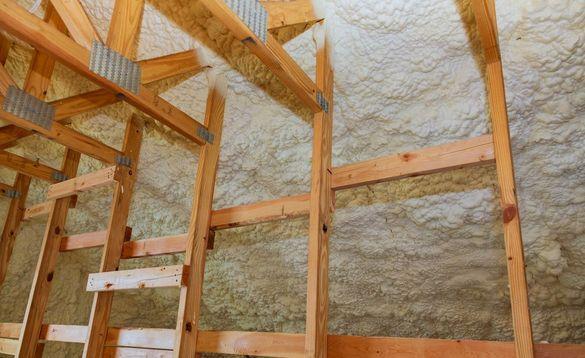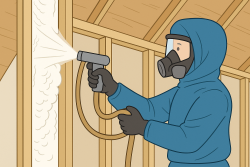Good insulation can prevent moisture, mould and mildew from spreading through your home. Read our blog to learn more about health risks and what can be done.
Mould in your home is not only unsightly and unhygienic—it’s also bad for your health. Luckily, having good insulation can keep household mould at bay. At Reitzel Insulation, we install mould-resistant insulation as well as vapour barriers to keep the moisture that leads to mould from penetrating your home. Read on to learn more about the dangers of household mould and how your insulation can help keep your home fungus-free.
WHAT IS MOULD AND WHERE DOES IT FORM?
Mould is a type of fungi that grows from microscopic spores travelling through the air. It can grow indoors in damp, poorly ventilated areas and is commonly found on walls, ceilings, bathroom tiles, carpets, sinks, tubs and wood. Moisture from breathing, cooking, bathing and doing laundry inside the home causes condensation to build up on household surfaces, creating the ideal conditions for mould to form.
Your kitchen and bathroom are two of the rooms most likely to have a mould problem as they’re places where excess moisture often accumulates. Basements also tend to attract mould because they’re frequently damp and poorly insulated.
HEALTH RISKS OF MOULD
While mould plays an important role in the earth’s ecosystem, it’s not something you want in your home as it can jeopardize the health and well-being of you your family members. Inhaling mould spores inflames your airways and may produce symptoms like nasal congestion, wheezing, coughing, chest tightness, and throat irritation.
Over time, exposure to mould can reduce lung function and lead to chronic problems like asthma. If you already have allergies or asthma, your symptoms are likely to be more severe if you come into regular contact with mould. Infants, children and seniors face greater health risks from mould than adults do.
HOW INSULATION HELPS PREVENT MOULD GROWTH
Good insulation controls the amount of moisture in your home by effectively sealing off the outdoors. In addition to causing mould, too much moisture inside your wall cavities can many building materials to deteriorate or corrode, which compromises the structural integrity of your house.
Certain types of insulation are better at controlling mould than others. For instance, spray foam insulation is particularly effective at preventing mould because it can easily be used to seal off small cracks and crevices and restrict air and moisture flow.
Some blown insulation, which is most commonly used in attics, can also help with controlling the condensation that leads to mould. For example, cellulose insulation, a “green” insulating material mostly made out of recycled paper products, is treated with boric acid, which is resistant to mould as well as fire, insects and rodents.
WHAT ARE VAPOUR BARRIERS?
Even with high-quality insulation, it can still be difficult to rid your home of mould. If this is the case, you may want to consider installing batt insulation along with vapour barriers. A vapour barrier is a thin film that’s applied over the insulation to prevent moisture from passing through. This keeps condensation from building up on your walls.
In a colder climate such as can be found in Ontario, the vapour barriers should be installed on the inside of the insulation (between the insulation and the interior wall) to prevent warm air from carrying moisture through your walls and forming condensation on the exterior walls of your home.
HOW TO DETECT AND REDUCE MOULD IN YOUR HOME
Mould is sometimes difficult to spot until it’s become a serious problem. Some telling signs of mould growth include:
- A stale, musty odour
- Clusters of small black or brown spots on your walls, ceilings, floors, furniture or appliances
- Strange stains or peeling paint on walls, floors or ceilings (signs of excess moisture)
- An increase in allergic symptoms like sneezing, coughing and nasal congestion
Keep in mind that while it’s usually black or brown in colour, mould can also appear grey-brown, gray-green, orange or even purple.
If you find mould in your home, you can reduce the problem by taking steps to control moisture levels in your home. In addition to upgrading your home’s insulation and installing vapour barriers, make sure that the rooms in your home where moisture tends to build up—such as your bathroom, kitchen and laundry room—are properly ventilated. Use exhaust fans when cooking and showering, dehumidifiers during periods of high humidity and vent appliances that produce moisture (like stoves and clothes dryers) to the outside rather than the attic.
If you do find mould on the walls or other surfaces in your home, you can try making cleaning solutions to eradicate it using diluted amounts of products like vinegar, bleach, baking soda and ammonia. However, if you can’t control the problem yourself, you should call a mould abatement specialist to deal with the issue before it negatively impacts your family’s health or causes structural damage to your home.
INSULATE YOUR HOME AGAINST MOULD - CONTACT REITZEL INSULATION!
If you’re looking for insulation contractors in Ontario, get in touch with us at Reitzel Insulation. We have 46 years (and counting!) of experience in the insulation business and have completed over 100,000 residential and commercial projects. Our team is trained to work with all kinds of insulation and will work with you to find just the type to help with mould prevention. To book an appointment with our insulation experts, contact us today or call us toll-free at 1-877-868-0456.


















